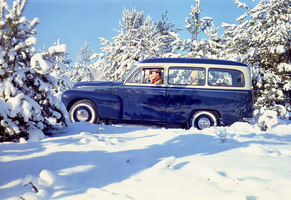|
Send this page to a friend! Fill in the form bellow | ||
Classic Cars
Volvo Celebrates 60 Years of the PV445 Duett
It laid the groundwork for the long history of Volvo wagons
Volvo VolvoSweden, 1927 > present49 models
VolvoSweden, 1927 > present49 models
4535 photos
6 videos
celebrated the 60th anniversary of the PV445 DuettVolvo PV445 DuettSweden, 1953 > 1969 on July 4, which was the company’s first mass produced station wagon, and started the long history of Volvo wagons.
In 1947, three years after the PV444 Volvo PV 444Sweden, 1944 > present was introduced, Volvo decided that there was a demand from passengers and commercial customers for more space. It took two years for the PV445 to come to fruition, and production began in the summer of 1949.
Volvo PV 444Sweden, 1944 > present was introduced, Volvo decided that there was a demand from passengers and commercial customers for more space. It took two years for the PV445 to come to fruition, and production began in the summer of 1949.
Because of the way the PV444 was made, the PV445 required its own chassis, but it borrowed as many parts as possible from the PV444. Volvo was still a small car company after all. The bumpers, hood and front fenders were all taken directly from the PV444. The PV445 got a unique five-bar grill. Volvo made the PV445 initially as just a cabin. Buyers had to go to a coachbuilder to get the rest. The variety of body styles included a wagon, commercial van and even some pickups. They were common as hearses and ambulances in Sweden. To carry the extra payload, the rear suspension was replaced with leaf springs instead of the coil springs on the PV444.
Power for all of the versions from a 1.4-liter pushrod four-cylinder with 40hp. The high payload weight and lower power forced Volvo to use very low gearing. Acceleration was fine for a commercial vehicle, but it was noisy and not fuel-efficient.
The PV445 Duett did not come in 1952 and was basically an accident. Volvo had 1,500 unsold PV445s at its factories, and it angered Volvo President Assar Gabrielsson. He commanded that Volvo convert the cars itself into station wagons. A body was quickly designed, and the first car was delivered on July 4, 1953, to Gabrielsson.
The name Duett came from Volvo’s marketing team who advertised the car as serving two needs. During the week, it could be a commercial van, but on the weekend there were seats for hauling the family. Volvo offered the car with or without side windows.
For 1960, Volvo refreshed the car with a one-piece windshield and four-speed transmission. In 1962, Volvo added the B18 engine that stayed in its cars until the 70s and was bored to 2.0-liter later for the 200-Series Volvo 200 SeriesSweden, 1974 > 199322 versions
Volvo 200 SeriesSweden, 1974 > 199322 versions
53 photos
in the 80s.
The Duett stayed in production up until 1969 when it could no longer pass crash tests, not bad for a car that has roots going back to 1947. Volvo built 101,492 PV445. The final car built is still in Volvo’s museum.
Encyclopedia |
Contribute
latest articles


popular articles










